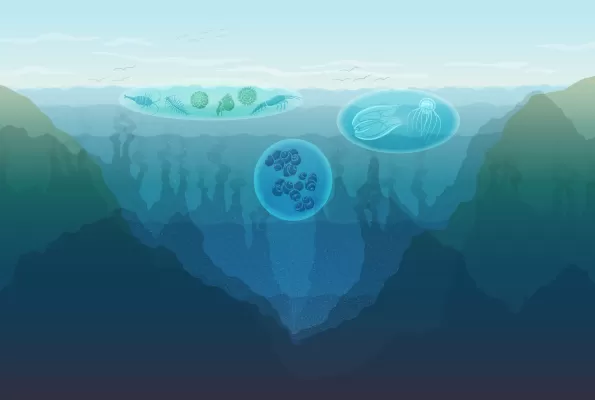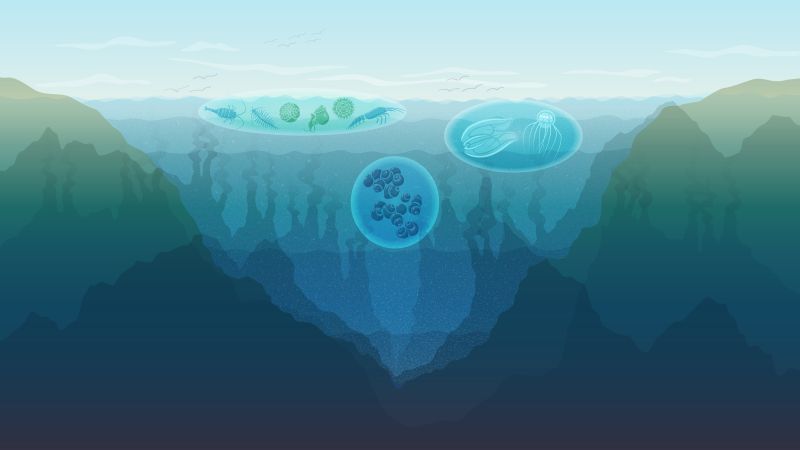
Dive into research on world's ocean
NSF helps create a comprehensive picture from the surface to the depths
As you dig your toes into the warm sand and watch waves crash into each other on a coastal beach, you might stop to wonder, what lives in the ocean? What is it about the vast, temperamental sea that inspires poets, writers and artists?
Sunlit zone
The sunlit zone, also called the euphotic zone, starts at the ocean's surface and extends down approximately 200 meters (656 feet). Sunlight penetrates the entire zone; however, half the light is absorbed in the top few meters and only about 1% remains at the 100-meter mark.
The sunlit zone makes up just about 3% of the ocean by volume but hosts the foundation of the ocean's food web, phytoplankton, which converts sunlight to energy using photosynthesis.NSF-supported research recently found that currents in the subtropical ocean can push the tiny floating phytoplankton down where there is not enough light for them to survive. "It's often a one-way trip for these organisms, but by taking this trip, they play a critical role in connecting different parts of the ocean," Mara Freilich, an assistant professor at Brown University, said in a university press release. The transported phytoplankton bring a significant amount of carbon from the surface, which helps feed deeper-dwelling organisms.
Twilight zone
The twilight zone, or mesopelagic zone, extends from 200 to 1,000 meters (3,300 feet) below the ocean surface. It begins where light levels are too low for photosynthesis and ends where visible light disappears. To adapt to the minimal light, approximately three-quarters of the zone's inhabitants use bioluminescent communication by giving off flashes of light.
The comb jelly, or ctenophore, glides from the twilight zone to shallow waters at night and back down during the day. It has a translucent oval-shaped body with eight rows of tiny comb-like plates that it uses to move through the water. When photographed under white light, the comb rows diffract light and produce a neon rainbow effect.NSF-supported researchers used genetic markers to discover that the graceful gelatinous creatures are likely the most distant relative of all animals — even sponges. Their work helps us understand how animals are related to each other and how they evolved.
Before that discovery, the researchers found a new way to identify ctenophores using genetic sequences, even from stray DNA in cells shed into the seawater. To use this "environmental DNA" to identify ctenophore species, Steve Haddock, a marine biologist at the Monterey Bay Aquarium Research Institute, and his team developed new genetic primers, which are gene codes that can easily identify in different species.
Midnight zone
The midnight zone, or bathypelagic zone, extends to about 4,000 meters (13,100 feet), which reaches the seafloor in some places and sits in total darkness. By the time food produced in the sunlit zone sinks to the midnight zone, there's not much left. To adapt to those conditions, some animals live near hydrothermal vents, openings in the sea floor that release heated mineral-rich waters.NSF-supported researchers are studying a foundational species of snail that has a codependent relationship with bacteria. The bacteria live in the snail's tissues and use chemosynthesis to convert chemicals in the vent fluid into food. "The snails don't have to eat anymore," said Roxanne Beinart, a professor at the University of Rhode Island. "It's like if we had plants growing in our stomachs."
To get to the hydrothermal vents, Beinart and her team use remotely operated vehicles that attach to a ship on a long tether. "It acts as our eyes and hands on the seafloor," she said. The researchers collect the snails, which can reach softball sizes, and study them to better understand the snail's symbiotic relationship with bacteria.
Abyssal zone
The abyssal zone is completely devoid of sunlight and reaches depths of 3,000 to 6,500 meters (9,842 to 21,325 feet). This zone spans about half of the planet.
Food produced in the sunlit surface zone sinks through the other zones to the abyssal zone. This food source, called "marine snow," includes small and larger particles that feed creatures on the abyssal plains.To measure how much of the marine snow makes its way to the abyss, Jeffrey Drazen, a professor at the University of Hawaii at Manoa, and his team collected samples and identified very tiny food particles with a specific chemical signature. As they looked deeper into the ocean, they noticed that sea cucumbers and urchins had the same chemical signature in their bodies, indicating that they had eaten the tiny particles. "Our findings identified a significant source of energy to the deep-sea food web," Drazen said.
To help bring similar stories from the abyss to a wider audience, NSF is funding a team to create a short film on deep ocean science expeditions to study microscopic larvae, which repopulate areas damaged by mining and trawling. The team plans to show the film in science centers countrywide and offer virtual reality and augmented reality learning tools to enhance the experience.
Hadal zone
If you sink deeper than the abyss, you end up in the hadal zone. This zone only includes seafloor trenches. The most famous, the Mariana Trench, is the deepest oceanic trench and home to the lowest point on Earth, the Challenger Deep, almost 11,000 meters (36,000 feet) beneath the surface. The trench is in the Western Pacific, just off the Mariana Islands near Guam.
Robert Stern, a professor at The University of Texas at Dallas, has studied the Marianas since the 1970s. Stern collaborated with researchers in Japan to send manned submersibles and remotely operated vehicles to study the crust and exposed mantle rocks on the slopes of the trench above the Challenger Deep.Stern and his collaborators sampled those exposed rocks and discovered a crust-mantle transition zone at about 5,800 meters depth. The team collected and analyzed minerals to determine that this crust formed about 50 million years ago when the Pacific Plate started subducting. This crust is stretching, allowing magma to intrude and erupt at some of the deepest volcanoes on Earth.
An NSF-funded team will be heading out later this year to study the crust and exposed mantle rocks using the remotely operated vehicle Jason/Medea. Researchers will also be looking at unusual evidence for more recent igneous activity near the trench, which could reveal how Earth's mantle is oozing magma into this region.
Seas for all kind
The journey from the sunny surface to the bottom trenches of the sea illuminated (literally, in the case of the comb jelly) hidden scientific wonders that motivate NSF-supported researchers to learn more.
The next time you head to the beach and gaze at the ocean, you might also feel inspired to ask a probing scientific question or smile knowingly as you think about a codependent snail and its bacteria or imagine tiny, sinking specks of marine snow.









